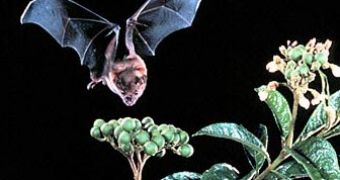Most plants are loaded with compounds generically called secondary metabolites that act as a defense method for them in that they are toxic for animals. Caffeine is such an example. Many plants we eat may be loaded with toxins, except for the parts we actually consume, like is the case of the potato or tomato.
Nevertheless, wild animals cannot select non-toxic varieties of plants for consumption. Instead, some of them use a method also used by human populations in Africa, Asia and South America for detoxifying the organism (especially in the case of pregnancy and lactation): eating mineral-rich clay. A new research published in the online journal PLoS ONE and carried out by a team from the Berlin Leibniz Institute for Zoo and Wildlife Research (IZW), Boston University and Cornell University has included fruit-eating bats in this category.
Tropical fruit-eating bats, important seed dispersers in the tropical forests, consume large quantities of plant secondary metabolites during their nocturnal foraging trips. Pregnant or lactating bat females are the most vulnerable, as the toxins can harm the development of the embryo or the juvenile. The solution seems to be quite similar to what humans would do too.
The research team captured pregnant and lactating bat females belonging to a species that consumes both insects and fruits, part of the Stenodermatinae group (family Phyllostomatidae), at the mineral licks in the Amazonian rainforest of eastern Ecuador.
"At first glance it seemed that bats visit these sites for the same purpose as other animals such as large tapirs or birds, i.e. to meet their daily mineral requirements. To our amazement, we found fruits to be relatively rich in minerals compared to insects," said co-author Dr. Christian Voigt.
Gestation and lactation do indeed require increased intakes of minerals. With all that, even if insects and not fruits presented a deficient mineral level for healthy bat reproduction, only bats consuming mostly fruits visited the mineral licks. The explanation was that female bats increase the fruit percentage in their diet during pregnancy and lactation, exposing themselves more to the toxic effects of the plant metabolites. The bat females compensated this by ingesting mineral rich clay or water. Just like humans do.

 14 DAY TRIAL //
14 DAY TRIAL //